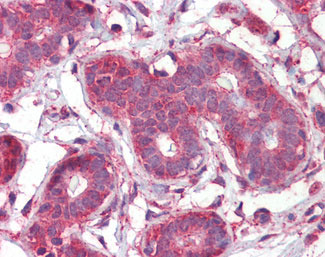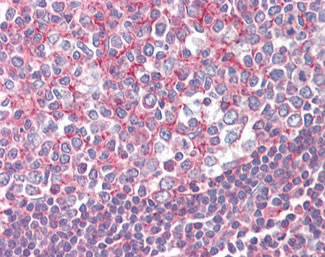SEPT2 / Septin 2 Antibody (N-Terminus)
Goat Polyclonal Antibody
- SPECIFICATION
- CITATIONS
- PROTOCOLS
- BACKGROUND

Application
| WB, IHC-P, E |
|---|---|
| Primary Accession | Q15019 |
| Reactivity | Human, Mouse, Rat, Rabbit |
| Host | Goat |
| Clonality | Polyclonal |
| Calculated MW | 41kDa |
| Dilution | ELISA (1:32000), IHC-P (2.5 µg/ml), WB (0.05-0.2 µg/ml) |
| Gene ID | 4735 |
|---|---|
| Other Names | Septin-2, Neural precursor cell expressed developmentally down-regulated protein 5, NEDD-5, SEPT2, DIFF6, KIAA0158, NEDD5 |
| Target/Specificity | Human SEPT2 / Septin 2. Reported variants represent identical protein: NP_001008492.1, NP_006146.1, NP_004395.1, NP_001008491.1. |
| Reconstitution & Storage | Store at -20°C. Minimize freezing and thawing. |
| Precautions | SEPT2 / Septin 2 Antibody (N-Terminus) is for research use only and not for use in diagnostic or therapeutic procedures. |
| Name | SEPTIN2 (HGNC:7729) |
|---|---|
| Function | Filament-forming cytoskeletal GTPase. Forms a filamentous structure with SEPTIN12, SEPTIN6, SEPTIN2 and probably SEPTIN4 at the sperm annulus which is required for the structural integrity and motility of the sperm tail during postmeiotic differentiation (PubMed:25588830). Required for normal organization of the actin cytoskeleton. Plays a role in the biogenesis of polarized columnar- shaped epithelium by maintaining polyglutamylated microtubules, thus facilitating efficient vesicle transport, and by impeding MAP4 binding to tubulin. Required for the progression through mitosis. Forms a scaffold at the midplane of the mitotic splindle required to maintain CENPE localization at kinetochores and consequently chromosome congression. During anaphase, may be required for chromosome segregation and spindle elongation. Plays a role in ciliogenesis and collective cell movements. In cilia, required for the integrity of the diffusion barrier at the base of the primary cilium that prevents diffusion of transmembrane proteins between the cilia and plasma membranes: probably acts by regulating the assembly of the tectonic- like complex (also named B9 complex) by localizing TMEM231 protein. May play a role in the internalization of 2 intracellular microbial pathogens, Listeria monocytogenes and Shigella flexneri. |
| Cellular Location | Cytoplasm. Cytoplasm, cytoskeleton. Cytoplasm, cytoskeleton, spindle. Chromosome, centromere, kinetochore. Cleavage furrow. Midbody Cytoplasm, cell cortex. Cell projection, cilium membrane. Cell projection, cilium, flagellum. Note=In metaphase cells, localized within the microtubule spindle. At the metaphase plate, in close apposition to the kinetochores of the congressed chromosomes. In cells undergoing cytokinesis, localized to the midbody, the ingressing cleavage furrow, and the central spindle. During bacterial infection, displays a collar shape structure next to actin at the pole of invading bacteria. In epithelial cells, colocalizes with polyglutamylated tubulin around the trans-Golgi network, as well as juxatnuclear and proximal Golgi apparatus. Localizes at the base of the cilia near the morphological distinction between the cilia and plasma membranes. Found in the sperm annulus (PubMed:25588830). |
| Tissue Location | Widely expressed. Up-regulated in liver cancer. |

Thousands of laboratories across the world have published research that depended on the performance of antibodies from Abcepta to advance their research. Check out links to articles that cite our products in major peer-reviewed journals, organized by research category.
info@abcepta.com, and receive a free "I Love Antibodies" mug.
Provided below are standard protocols that you may find useful for product applications.
Background
Filament-forming cytoskeletal GTPase. Required for normal organization of the actin cytoskeleton. Plays a role in the biogenesis of polarized columnar-shaped epithelium by maintaining polyglutamylated microtubules, thus facilitating efficient vesicle transport, and by impeding MAP4 binding to tubulin. Required for the progression through mitosis. Forms a scaffold at the midplane of the mitotic splindle required to maintain CENPE localization at kinetochores and consequently chromosome congression. During anaphase, may be required for chromosome segregation and spindle elongation. Plays a role in ciliogenesis and collective cell movements. In cilia, required for the integrity of the diffusion barrier at the base of the primary cilium that prevents diffusion of transmembrane proteins between the cilia and plasma membranes: probably acts by regulating the assembly of the tectonic-like complex (also named B9 complex) by localizing TMEM231 protein. May play a role in the internalization of 2 intracellular microbial pathogens, Listeria monocytogenes and Shigella flexneri.
References
Nagase T.,et al.DNA Res. 2:167-174(1995).
Mori T.,et al.Cytogenet. Cell Genet. 73:224-227(1996).
Hu G.,et al.Submitted (DEC-1997) to the EMBL/GenBank/DDBJ databases.
Ota T.,et al.Nat. Genet. 36:40-45(2004).
Hillier L.W.,et al.Nature 434:724-731(2005).
If you have used an Abcepta product and would like to share how it has performed, please click on the "Submit Review" button and provide the requested information. Our staff will examine and post your review and contact you if needed.
If you have any additional inquiries please email technical services at tech@abcepta.com.













 Foundational characteristics of cancer include proliferation, angiogenesis, migration, evasion of apoptosis, and cellular immortality. Find key markers for these cellular processes and antibodies to detect them.
Foundational characteristics of cancer include proliferation, angiogenesis, migration, evasion of apoptosis, and cellular immortality. Find key markers for these cellular processes and antibodies to detect them. The SUMOplot™ Analysis Program predicts and scores sumoylation sites in your protein. SUMOylation is a post-translational modification involved in various cellular processes, such as nuclear-cytosolic transport, transcriptional regulation, apoptosis, protein stability, response to stress, and progression through the cell cycle.
The SUMOplot™ Analysis Program predicts and scores sumoylation sites in your protein. SUMOylation is a post-translational modification involved in various cellular processes, such as nuclear-cytosolic transport, transcriptional regulation, apoptosis, protein stability, response to stress, and progression through the cell cycle. The Autophagy Receptor Motif Plotter predicts and scores autophagy receptor binding sites in your protein. Identifying proteins connected to this pathway is critical to understanding the role of autophagy in physiological as well as pathological processes such as development, differentiation, neurodegenerative diseases, stress, infection, and cancer.
The Autophagy Receptor Motif Plotter predicts and scores autophagy receptor binding sites in your protein. Identifying proteins connected to this pathway is critical to understanding the role of autophagy in physiological as well as pathological processes such as development, differentiation, neurodegenerative diseases, stress, infection, and cancer.





